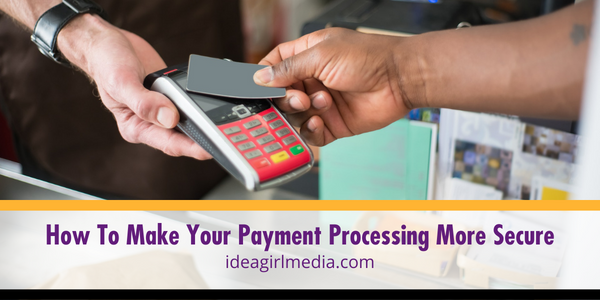What is a payment processor?
What is a payment processor? Why do you want one in place for your business? Payment processing companies make it easier than ever to offer secure payment options that foster customer loyalty. Here are five easy steps to take now...
5 Payment Processing Steps Your Customers Will Thank You For Taking
Insecure payment processing practices could make you a target for fraudsters and thieves. There are many measures you can minimize risk for you and your customers.
How to make your payment processing more secure? This article outlines five ways to do it.
Use A Secure Online Payment Gateway
If you allow customers to pay at your website, you absolutely need to have a secure payment gateway set up.
While you can create your own payment processing center web page or portal, most companies prefer to use a trusted third-party platform, as there is much less chance of the gateway being hacked. Payment gateways are also more trusted by customers, helping you covert more sales.
Compare some of the most trusted online payment gateways here.
Require Strong Passwords For Customer Accounts
Many company websites encourage customers to make accounts before making a purchase. Should your brand choose that path, it’s important to understand that these accounts cannot be easily hacked.
Require strong passwords from customers to avoid high risk. Ask that passwords to be a certain length by using a mix of:
- Upper case letters
- Lower case letters
- Numbers
- Special characters or symbols
It’s also worth setting up a secure system for resetting passwords in case a customer forgets theirs.
Choose A Semi-Integrated POS Payment System
In-store payments should have a Point Of Sale (POS) system. Some companies use integrated systems: POS systems that handle everything from inventory management to Square payment processing (and other branded gateways).
However, such systems are typically not as secure as semi-integrated systems -- POS systems using third-party payment processing software so that no sensitive payment information is stored on the POS system itself. You can learn more about semi-integrated payment solutions here.
Merchant Payment Processing: Allow Customers To Use Credit Cards
Credit card payments have solid advantages. They are typically necessary for businesses that deal with large transactions. They are also a secure option.
If a fraudster pays for something using someone else’s credit card, the credit card company has policies that will refund it if a claim is made. In turn, the credit card company takes the action, freeing you, the merchant, from any legal predicament. This is not always the case with debit cards.
When accepting credit cards you may want to charge a merchant fee on every purchase. Some brands take a more customer-friendly path by setting minimum payment limits.
Take time to read the guides on accepting credit card payments and expanding your payment options online.
Stop Accepting Checks
Does your company still accept checks?
Most companies have stopped accepting checks. Some still accept this form of payment. The problem with checks is that they can bounce if the customer doesn't have enough money in their account.
Checks can also be fraudulently written. You may experience customers paying by check and then disappearing. Chasing these payments will not be easy and you may not see the funds.
In fact, monetary checks are one of the least secure payment options and can be easily phased out.
4 Replies
-
Hello! I could have sworn I’ve been to this site before but after checking through some of the post I realized it’s new to me. Anyways, I’m definitely glad I found it and I’ll be bookmarking and checking back often!
-
really helpful as a ecommerce business owner how to make payments and eventually business more secure as it is all digital much appreciated
Leave a Reply

Like what you see? We've been told our blog posts are like potato chips: You can't read just one...
Subscribe to receive them fresh in your Inbox, and you can grab our best insights about social media marketing before everyone else sees it!

Relevant Resources
view allThe True Cost Of Letting Peak Sales Periods Pass You By

Three Surprising Signs You’re Still Silencing Your Female Employees

How Ongoing Training In The Workplace Can Drive Long-Term Business Growth






































By Medium Hairstyles on